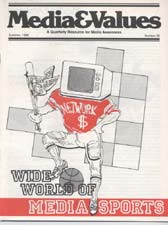No Two Countries See the Same Olympics
|
This article originally appeared in Issue# 36
|
Do the Olympics divide or unite? In a special interview for Media&Values, researcher Michael Real examines the political and social impact of this worldwide communications event.
Millions of Americans were virtually glued to their TV sets during the 1984 Olympic Games in Los Angeles.
But the extensive and exclusive coverage provided by the American Broadcasting Company (ABC) did not make a hit with one group of viewers — the foreign athletes residing in the official Olympic villages.
Village monitors were turned to the same edited-for-America programming that came into U.S. living rooms, but its tone and selection irritated some athletes so much that they filed a letter of protest.
Unfortunately, what they failed to realize was that only the United States saw what ABC provided. Other countries used ABC only as a photography feed to produce their own programs with their own commentators. Around the world, their friends and families saw many different national variations.
This story, told by Michael Real, chair of the department of telecommunications and film, San Diego State University, emphasizes a fact that's probably a surprise to most viewers.
"No two countries see the same Olympics," Real stated in an interview discussion of a world-wide research project he directed for UNESCO on Olympic media coverage.
Without question, the media, especially television, have shaped the modern Olympics, which is now a very different contest from the gentleman-amateur eliteness of its early days. Mediagenic distortions are visible in everything from the emphasis (and extra financial support) given to the more photogenic sports to the timing of events. The 1988 Korean Olympics, in fact, is already being called the "breakfast Olympics" because of early-morning scheduling to fit the preferences of North American viewers time zones away.
Multiple Views
Host broadcaster biases and experience do shape coverage, of course, Real said. For example, no American footage could match the expertise expected of volleyball coverage in Japan, and Europe and Latin America were unhappy with the quality as well as the quantity of soccer coverage.
In fact, the view from abroad amounts to a national portrait of the broadcasting country, Real says. For example, Indians are big for field hockey, Britains and Australians lean toward equestrian events, and Japan indulges its traditional fascination with wrestling. Preferences reflect history, economics and social conditions, although smaller, poorer countries often favor individualistic sports like track and field over team efforts. Real speculated that this results from the opportunity for success these sports offer a single talented individual. Launching a successful team for group sports requires a much greater investment of talent and capital.
Reporting during the Olympics emphasized the vast numbers of the world's people — up to 2.5 billion — who watched the games. Real continued. But the heavy viewing rates weren't spread evenly.
In a developed country, the audience might have been as much as 90% but in some parts of the Third World, it was only a small fraction of the population. "In Nigeria, for example, which is not the poorest country, only 10% of the population saw the Olympics."
All these factors need to be considered in evaluating the Olympics as a unifying international event, Real added.
Its role in bringing the world's people together was what Real set out to study when he began contacting researchers in 25 countries around the world about follow-up studies of broadcast and print coverage. The eventual result, a book-length study, summarizes research that was eventually performed on six continents with a widespread geographic distribution.
Western and Eastern bloc domination of medals and coverage also represents a psychological block to poorer countries, whose lower-ranked athletes may end up being almost invisible, or. if featured. may be shown losing.
And superpower competitiveness and propaganda also open coverage up to ideology and political maneuvering like that represented by the two successive U.S/Soviet boycotts of the 1980 and 1934 Olympics.
Coming Together
With all these opportunities for misinterpretation, does the Olympics promote international understanding? Real believes so, if only because it provides perhaps the only form that all the world's people can share, if only imperfectly "a global celebration around the international campfire."
Like its ancient Greek predecessor it also requires non-belligerent cooperation and contact between the world's countries.
As Real points out, Yugoslavian coverage of the successive summer and winter games was completely different in tone. The "hometown" Sarajevo games were presented as an example of the Olympic ideal. Yugoslavian coverage of the summer games in Los Angeles, however, centered on the boycott and commercialism.
The two cities shared one other opportunity, however — the chance to present themselves to the world. As a result of their starring roles in these successive games, both cities seem to have improved their international self-image. This chance to visit" each successive host for a shared festival may be what modem televised games are really most about.



